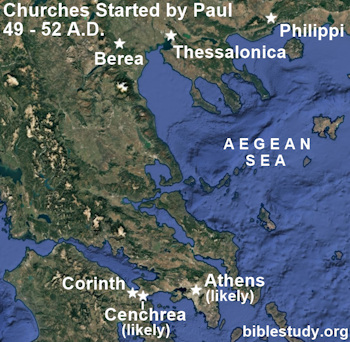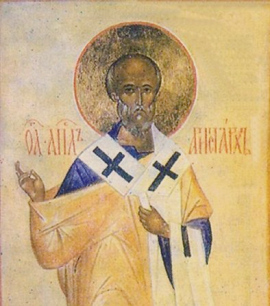Written in 51 A.D. from Corinth, the second letter to Thessalonica is the second (chronologically speaking) of Apostle Paul's fourteen New Testament books he wrote. The first one, 1Thessalonians, was authored in 50 A.D.
2Thessalonians is one of the earliest books that made its way into the New Testament. Only Matthew's gospel (35 A.D.), the book of James (40 to 41), the gospels of Mark and John (42) and 1Thessalonians were written before this epistle to Thessalonica.
[The Old Testament in the Gospels]
Apostle Paul does not record a single quote from the Old Testament in 2Thessalonians.
The second letter to Thessalonica is one of seventeen Biblical books, and one of eleven New Testament writings, that have a number at the start of their names.
Paul's second missionary journey, which was carried out between 49 and 52 A.D., was the most fruitful of all his journeys when it comes to churches started. During this evangelistic push he started Christian groups in Philippi (Acts 16), Thessalonica and Berea (Acts 17), as well as Corinth (Acts 18). He also likely started fellowships in Athens (Acts 17) and Cenchrea (Acts 18:11, 18, Romans 16:1 - 2, 27).
[Paul's Second Missionary Journey Map]
2Thessalonians is the seventh smallest Biblical book with only 1,032 words.

Paul's fellow evangelist and close friend Timothy is linked to him in several of his books. Timothy, in fact, is mentioned in Paul's greeting in six of his books (1Thessalonians, 2Thessalonians, 2Corinthians, Philippians, Colossians and Philemon).
Holy
Four of Apostle Paul's writings do not contain the word "holy" in the King James Bible. They are Galatians, Philippians, 2Thessalonians and Philemon. The Greek word hagios (Strong's Concordance #G40), which is commonly translated as "holy," is however found in 2Thessalonians. It is translated as the word "saints" as in some of Paul's other works (Philemon 1:5, Hebrews 6:10, etc.).
[What Does It Mean to be Holy?]
When he shall come to be glorified in his saints (hagios), and to be admired in all them that believe (because our testimony among you was believed) in that day (2Thessalonians 1:10).
End Time Apostasy
The English word "apostasy" comes from the Greek apostasia (Strong's Concordance #G646) which means a falling away or defection from (forsaking) God's truth. While the English word is not found in the King James Bible, the Greek is recorded in two places. In Acts 21, apostasia is translated as "to forsake" and in 2Thessalonians 2 it is "a falling away."
Let no man deceive you by any means: for that day shall not come, except there come a falling away (apostasia) first, and that man of sin be revealed, the son of perdition (2Thessalonians 2:3).
[What Does It Mean to be Anathema?]
Evil Miracles
Rebellious spirits can carry out miraculous acts, either directly or through those they possess, utilizing the power they received before they became demons. God, in the last days, will allow them to exercise their abilities so that those who have rejected the truth may be further deceived and taste the full fruit of the lies they believe.
For the mystery of iniquity doth already work: only he who now letteth will let, until he be taken out of the way . . . Even him, whose coming is after the working of Satan with all power (Greek dunamis) and signs and lying wonders . . . (2Thessalonians 2:7, 9).
Dunamis (Strong's #G1411), in 2Thessalonians, is used to describe a superhuman power that is supernatural in origin.
Name Dropper
Paul's second letter to Thessalonica, other than in its opening greeting, does not mention other humans by name even in its last chapter. Compare this with the last chapter of Romans, which Paul wrote in late 57 A.D. before he visited the city for the first time (Romans 1:10 - 11).
[Who Were Paul's Roman Relatives?]
In Romans 16 Paul mentions no less than 35 individuals, six of which may have been relatives. In the first chapter of 1Corinthians, penned in 56 A.D., he mentions six people by name that are not a part of his greeting (Chloe, Apollos, Cephas (Peter), Crispus, Gaius, Stephanas). In the last chapter of 1Corinthians he lists seven people by name!
Paying the Bills
Paul, when he visited Thessalonica, decided not to exercise his right to be financially supported (see Luke 10:7, 1Timothy 5:17 - 18) by the local church. He chose, instead, to work to pay his way.
Neither did we eat any man's bread for nought; but wrought with labor and travail night and day, that we might not be chargeable to any of you (2Thessalonians 3:8).
The apostle was not, however, solely supported by his own efforts. The poor but generous Philippian church, which Paul started before he arrived in Thessalonica, sent him money on two occasions!
Now ye Philippians know also, that in the beginning of the gospel, when I departed from Macedonia, no church communicated with me as concerning giving and receiving, but ye only.
For even in Thessalonica ye sent once and again unto my necessity (Philippians 4:15 - 16).
The church in Philippi also initiated sending financial support to Paul when, after leaving Thessalonica, he traveled to Corinth to evangelize the city (2Corinthians 11:8 - 9).
A Faithful Christian
Aristarchus was a faithful Christian from Thessalonica who aided the Apostle Paul during his ministry. He first Biblical mention is as one of the men who accompanied Paul to Ephesus during his third missionary journey. When a mob formed in support of the pagan goddess Diana (and against Paul), both Aristarchus (Acts 19:29) and another believer were seized but soon released.
[Paul's Fourth Missionary Journey Map]
Aristarchus, along with others, continued with Paul on the rest of his third missionary campaign which took him to Corinth and back through Macedonia to Asia (Acts 20:4). The group eventually arrived in Jerusalem.

When the apostle was sent as a prisoner from Caesarea to Rome for his first trial, he accompanied him as a fellow prisoner (Acts 27:2, Colossians 4:10). His last mention is as a prisoner in Rome when Paul wrote the book of Philemon between 61 and 63 A.D.
Paul considered Aristarchus of Thessalonica a faithful fellow laborer in spreading the gospel to the world (Philemon 1:24).
A Greek Metropolis
Thessalonica was founded in 315 B.C. by Cassander, a relative of Alexander the Great. At the time of Paul's visits in the middle of the first century A.D. it had been designated a Roman free city. This meant, among other benefits, that it did not have a Roman army garrison within its walls.
[Alexander the Great's Empire Map]
In Paul's day Thessalonica, along with Corinth, were the two most important economic centers of all Greece. It was Macedonia's capital and most populous city which also hosted the province's largest port.
Thessalonica, unlike many other cities, continued to stay a vital economic and political hub beyond the peak of the Roman Empire. From 330 to 1430 A.D. it was the second largest and most prosperous city in the Byzantine Empire. It was even considered a co-capital of the empire alongside Constantinople. It continued to remain a critical seaport even after it was conquered by the Ottomans in 1430.
21st century Thessalonica is the second largest Grecian city, boasting a metro population of just above one million. It has also retained its designation as the capital of the region of Macedonia.